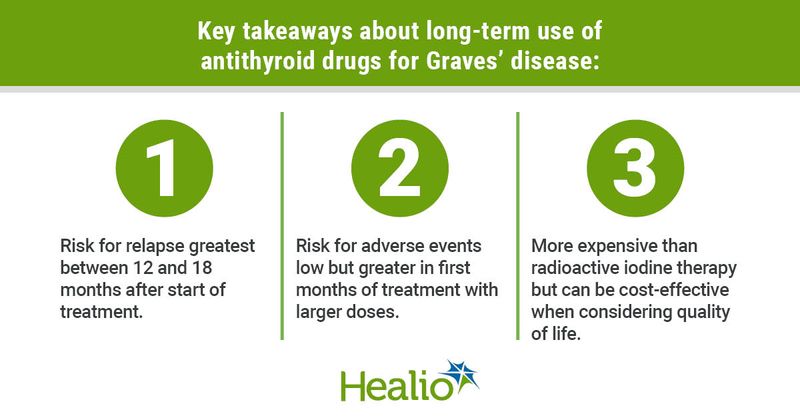Long-term antithyroid drugs effective therapy for Graves’ disease
Click Here to Manage Email Alerts
Long-term use of antithyroid drugs can be a viable alternative to ablative therapies for the management of Graves’ disease, according to a review article published in Clinical Endocrinology.

“As antithyroid drugs have become the most widely used treatment for Graves’ disease in the U.S., many clinicians and patients may consider long-term use of antithyroid drugs as opposed to the standard 12- to 18-month course, since the latter remains associated with high rates of relapse,” Omar M. El Kawkgi, MD, an endocrinologist at Mayo Clinic in Rochester, Minnesota, and Marius N. Stan, MD, a consultant in endocrinology at Mayo Clinic in Rochester, Minnesota, told Healio. “In this review, we aimed to evaluate the evidence behind long-term antithyroid drugs across important outcomes like thyroid status, quality of life, other biological outcomes and cost in comparison to ablative therapies.”

Researchers conducted a search of studies in the Ovid MEDLINE, Ovid Embase and Scopus databases through July 2020. Studies with the keywords Graves’ disease, long term, antithyroid drug, radioactive iodine, surgery, comparison and efficacy were included in the analysis, and references to the identified articles were also searched. There were 70 publications identified in the review.
Long-term euthyroidism

Researchers examined studies evaluating the efficacy of long-term antithyroid drugs at achieving and maintaining euthyroidism compared with the maintenance of euthyroidism during treatment of hypothyroidism after ablative therapies. One study showed antithyroid drugs are highly effective at normalizing triiodothyronine and thyroxine levels within 4 to 8 weeks. Another study, in which 179 patients with Graves’ disease were randomly assigned to antithyroid drugs and a block-and-replace strategy or radioactive iodine and surgery, showed the iodine cohort was slowest to achieve euthyroidism.
Researchers also cited a retrospective study that found long-term antithyroid drugs were effective at maintaining euthyroidism. In this study of 108 patients with Graves’ disease, 90% of those who were treated with antithyroid drugs for more than 2 years maintained euthyroidism for the duration of the study.
The risk for hypothyroidism is higher after radioiodine treatment compared with antithyroid drugs. In a study of patients with relapsed Graves’ disease randomly assigned to radioiodine or long-term antithyroid drugs and followed for 10 years, the prevalence of hypothyroidism in the radioiodine group was 21.1% vs. 9.1% in the antithyroid drug cohort. The risk for recurrent hyperthyroidism varied based on the duration of antithyroid drug treatment. Researchers found the risk for recurrence was highest 12 to 18 months after the start of antithyroid drug treatment and was lower after long-term antithyroid drugs.
Quality of life, health benefits
Researchers wrote that antithyroid drugs also provide quality of life and health benefits. A multicenter Swedish cohort study of patients with Graves’ disease found those treated with radioactive iodine had a worse quality of life score than antithyroid drug or surgically treated patients. Another study revealed those on antithyroid drugs had a lower risk for developing thyroid eye disease compared with those treated with radioiodine. A study in South Korea found patients with Graves’ disease treated with radioactive iodine had more symptoms on a psychotic checklist assessment compared with long-term antithyroid-treated adults. Researchers also cited a study in which radioactive iodine treatment was associated with an increase in body weight over 5 years compared with antithyroid drugs.
A review of patient safety studies showed major adverse events typically occurred within the first 3 months of treatment and then decreased significantly. One systematic review found major adverse events occurred in only 0.8% of patients during a mean of 5.8 years, whereas another found 1.5% of patients had a major adverse event during a median of 6 years.
“Many clinicians worry about adverse events with antithyroid drugs, namely hepatotoxicity and agranulocytosis,” El Kawkgi and Stan said. “Our review of the evidence showed that the incidence of such events is low with long-term antithyroid drugs and tended to occur mainly in the first few months of treatment with larger doses, suggesting that use of the lowest tolerated dose in the long term is reassuringly safe.”
Cost-effective alternative
In evaluating cost, an analysis from the U.K. and Australia found radioactive iodine was the least expensive first-line treatment for Graves’ disease. However, after factoring in health-related quality of life, long-term antithyroid drugs are likely a cost-effective alternative.
“With the high rates of relapse after a 12- to 18-month course of antithyroid drugs, decisions regarding further treatment are inevitable and should include long-term antithyroid drugs as an option in opposition to usual default of ablative therapies,” ElKawkgi and Stan said. “At that point in decision-making, our review of the evidence can be utilized by clinicians to inform treatment preferences ultimately leading to a shared individualized decision. For example, in a patient concerned about cost, clinicians can use this study to compare costs of long-term antithyroid drugs to ablative therapies and similarly across other patient-specific outcomes.”
For more information:
Omar El Kawkgi, MD, can be reached at elkawkgi.omar@mayo.edu
Marius N. Stan, MD, can be reached at stan.marius@mayo.edu
